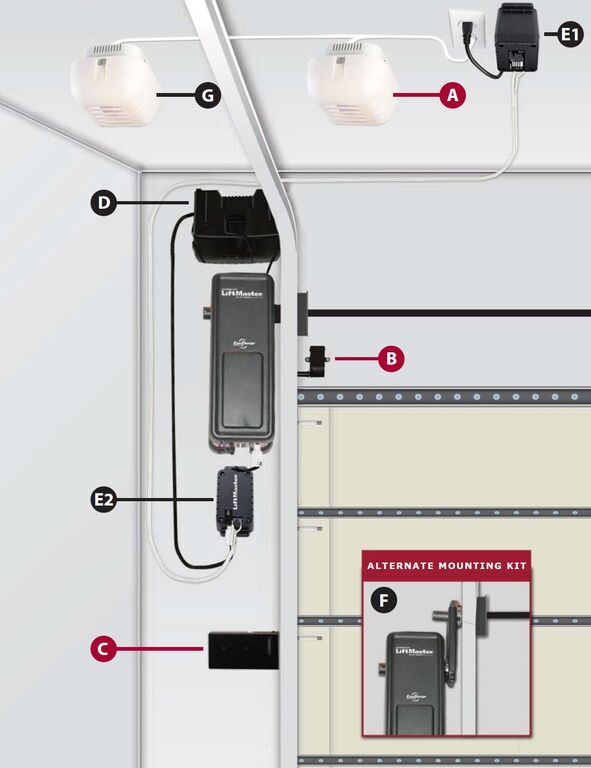Garage Door Opener
A garage door opener is a motorized device similar in function to the remote controls used for TVs and vehicles. It allows you to open or close your garage door wirelessly from inside your home with just the push of a button, providing convenience and enhanced security.
Purpose of Garage Door Opener
Garage door openers are designed to automate the manual process of opening and closing garage doors quickly and effortlessly. This innovation in home technology significantly improves ease of access, safety, and convenience for homeowners.
What Are the Different Types of Garage Door Openers?
Currently, there are three main types of garage door opener systems available: chain drive, screw drive, and belt drive. Each type offers its own unique advantages and disadvantages in terms of reliability, noise level, speed, and maintenance requirements.
1. Chain Drive
Chain drive openers rely on metal chains to move the trolley that lifts and lowers the garage door.
Pros: Known for their affordability, chain drives are the most popular type of garage door openers. They operate smoothly and relatively quietly with faster lifting speeds compared to some other models.
Cons: The metal chain is exposed to external elements, which can lead to faster wear and tear. Regular maintenance, including lubrication, is required to ensure optimal performance and longevity.
2. Screw Drive
Screw drive openers utilize a coiled steel threaded rod to pull the trolley along the track for door movement.
Pros: These openers are highly reliable and feature fewer moving parts, resulting in reduced maintenance. They are also durable and provide consistent performance.
Cons: Screw drive openers tend to be more expensive than chain drives and operate at slower speeds. Additionally, temperature fluctuations can affect their performance during extreme weather.
3. Belt Drive
Belt drive openers use reinforced rubber belts to move the trolley along the track.
Pros: Belt drives are the quietest type of garage door opener, offering smooth and frictionless operation powered by efficient DC motors. They are ideal for homes attached to living spaces.
Cons: They are generally more expensive and operate at slower speeds. Over time, rubber belts can wear out and require replacement.
How to Program a Garage Door Opener?
Programming your garage door opener is typically a straightforward process. The most common method involves using the manufacturer’s supplied remote control, but other options exist depending on your opener model.
Programming a Garage Door Opener with the Manufacturer’s Remote Control
To program your opener using the manufacturer’s remote, follow these steps after locating the programming code in your owner’s manual:
- Point the remote control at the opener and press the “Learn” button until the indicator light flashes.
- Press and hold the desired button on the remote for approximately three seconds.
- The garage door should activate, indicating successful programming. If not, repeat the process until the opener responds.
Programming a Garage Door Opener Without a Remote Control
If you don’t have a remote or want to add a new one, you can program your opener manually:
- Locate the control board on or near your garage door opener; it typically has a colored LED (red, green, or yellow).
- Power off the opener, then press and hold the “Learn” button until the light turns solid red.
- Restore power; the LED will go off, indicating programming mode.
- Press the button on your remote control that you want to sync.
- When the LED turns off, the programming is complete. Repeat if unsuccessful.
Programming Multiple Garage Door Openers
If you have several garage door openers, program each one individually by locating its programming code and following the standard steps. Using distinct remotes for each helps prevent interference and ensures reliable operation.
Additional Tips for Garage Door Opener Maintenance
To keep your garage door opener functioning smoothly, perform regular maintenance such as lubricating moving parts, inspecting the safety sensors, and ensuring the remote control’s batteries are fresh. Also, periodically test the door’s auto-reverse safety feature to prevent accidents. Keeping your opener clean and protected from moisture helps extend its lifespan and reduce the need for costly repairs.
Conclusion
Read more:An In-Depth Guide About Garage Door Types With Their Pros And Cons
Now that you understand how to program your garage door opener, you can enjoy hassle-free operation with greater security and convenience. Always keep your owner’s manual handy for reference and don’t hesitate to contact the manufacturer’s support team if you encounter any issues.
FAQs
This depends on your garage door opener’s model. Many modern openers support wireless keypads, while others may not. Check your operator’s manual to confirm compatibility and programming instructions.
A garage door can reverse due to obstructions in the track preventing smooth operation or issues with the safety sensors. Removing any blockage or realigning sensors typically resolves this problem.
Common causes include dead or weak batteries and radio interference affecting the remote’s signal. Replace batteries first, and if issues persist, consider resetting or reprogramming the remote.
Identify hinges, rollers, and sprocket wheels, then apply a high-quality lubricant or WD-40 spray to these parts. Open and close the door a few times afterward to distribute the lubricant evenly and ensure smooth operation.

























